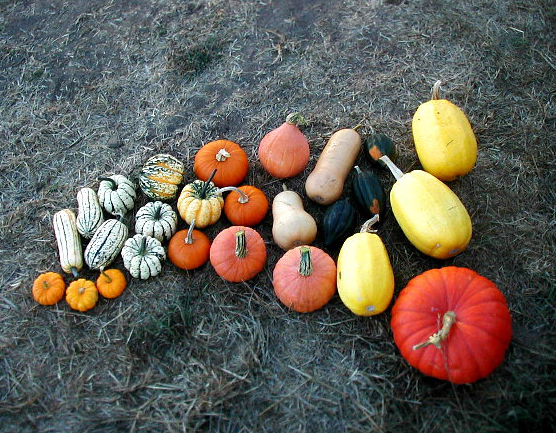But good as butternuts are, there's no reason to stop there. Right now the markets are lavishly stocked with every size and crazy streaked-and-spotted shape of winter squash. There's the delicate delicata, ivory-skinned with green stripes and orange flecks over a pale yellow-peach flesh. You can slice it into narrow half-moons, massage lightly with olive oil and bake until tender. The thin skin is edible to all but the most fastidious. For those folks, cut the squash in half lengthwise, scrape out the seeds and strings, and fill with an autumnal bread or wild-rice stuffing. Bake until squash is fork-tender and filling has browned and crisped.
There are other variations on the delicata, like the dumpling squash, shaped like an oversized popover and perfect for stuffing.
The squarish, dark green buttercup squash is for those who like their squash dry and nutty, tasting like a cross between roasted chestnuts and baked sweet potato. In their Ladybug newsletters, Andy and Julia of Mariquita Farm have sung the praises of two big beige squash, the plump, round-cheeked Long Island cheese pumpkin and the deeply grooved, deep-orange fleshed Musquee de Provence squash, also called the Fairytale pumpkin for its Cinderella-coach shape.
Although, if I were a mouse looking for glamor, I'd hitch myself to a Rouge Vif d'Etampes pumpkin and wait for the fairy godmother to descend. This is the most glamorous squash of all, vivid orange-red, huge and elegantly grooved. If you've ever wanted to make a pumpkin soup and serve it in a pumpkin, this is the one you want. Not surprisingly, given its shape and its tongue-twisting French name, it's often called the Cinderella pumpkin. Carved out, it also makes a striking ice bucket for an autumn brunch.
But my favorite remains a tricky-to-find recent hybrid, the Sunshine kabocha. Bright orange skinned, it's easy to confuse with the Red Kuri, but once tasted, it can't be mistaken for anything but its amazingly delectable self. Oh, all right, I'll admit it: roasted, it tastes like chicken. Or, even better, like the incredibly savory drippings left at the bottom of the pan after you roast a chicken. Trust me: if you think you don't like squash because you've only ever eaten those bland and pasty little baked acorn squash, you owe it your tastebuds to seek out--or grow--a Sunshine kabocha. A plain old kabocha is pretty good, too, sweet and nutty, but the Sunshine variety is just nubbly orange heaven.
Once you've done something virtuously savory with your roasted squash--soup, a suave puree--then it's time for a few treats. Squash, like applesauce, adds moisture without fat to baked goods, and it seems everyone turns out a loaf or two of low-fat pumpkin bread this time of year.
Then again, we are moving into hibernation weather and a holiday mood. At least once this month, follow the lead of Alameda home baker Steven Mounce and get every Peter Pumpkin Eater at your table moaning with pleasure over this lush pumpkin bread pudding. Trust Mounce: a man with the word "homemade" tattooed on his knuckles knows what you want.
Pumpkin Bread Pudding
Serves 6-8
Did you know that canned pumpkin is rarely actual pumpkin, but rather butternut or other winter squash? Whatever you call it, plain canned pumpkin is always a handy staple, since it can be used in both sweet and savory dishes. Of course, you can also roast and mash your own for this gorgeously warming centerpiece for brunch or dessert.
Ingredients:
4 eggs
2 cups half and half
15 oz can pumpkin (not pumpkin pie filling) , or 1 3/4 cups roasted, mashed butternut or kabocha squash
¾ cup brown sugar
3 tablespoons dark molasses
¼ teaspoon salt
1 teaspoon ground cinnamon
½ teaspoon freshly grated nutmeg
¼ teaspoon ground cloves
¼ teaspoon ground ginger
1 large loaf of French bread, cut into 2" cubes
½ cup walnuts, roughly chopped
¼ cup raisins or dried cranberries
3 tablespoons butter, softened
3 tablespoons brown sugar
Preparation:
1. In a large bowl, whisk eggs, half and half, pumpkin, brown sugar, molasses, salt, and spices together. Add bread cubes to bowl in batches, stirring well between each batch. Add only enough bread to soak up liquid mixture; you may not need all the bread. Let mixture rest for 15 minutes.
2. Preheat oven to 350 degrees F. Fill a kettle or pitcher with hot water, and set aside. Lightly grease an 8"x8" glass baking dish. Stir nuts and raisins into bread mixture. Spoon mixtures loosely into baking dish. Do not pack bread mixture into dish. Mound lightly above edge of the dish if necessary.
3. Place glass baking dish into a 13"x9" baking pan. Place both dishes on the center rack of the oven. Pour hot water into larger baking pan to come up halfway on the glass pan. Bake for 30 minutes, until top is golden brown and center is set. While bread pudding is baking, stir together butter and 3 tablespoons brown sugar, and set aside.
4. When pudding is baked, remove glass pan from oven and set on a rack. (Wait to remove water-filled pan until oven has cooled.) Dot with brown sugar mixture, which will melt into a gooey caramel sauce, mmm. Serve warm or at room temperature.
